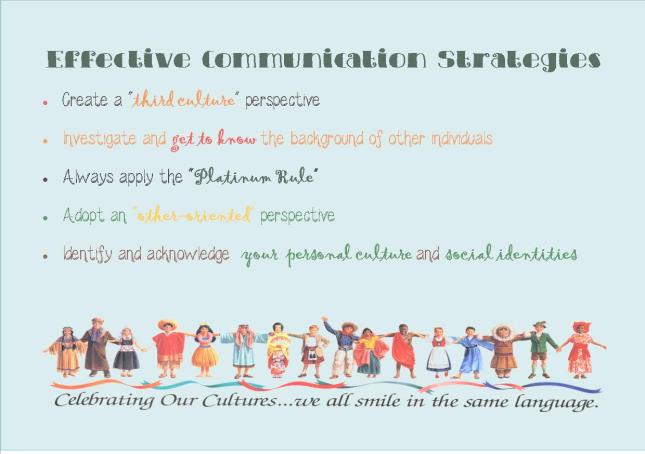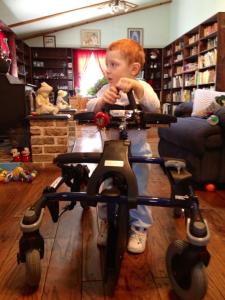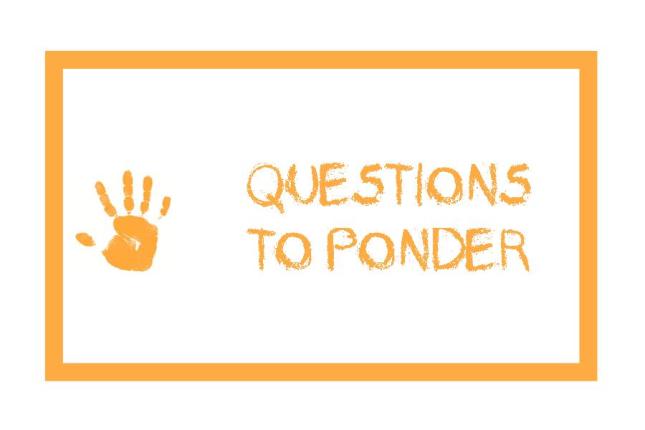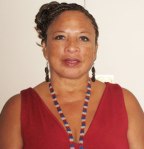Culture is all around us … quite literally. No matter where we go, there will be some type of diversity we encounter. Whether it is at the grocery story, in a discussion post, or even within our own families, there will always be similarities and differences that someone has to contribute to cultural diversity. Yet, did you ever stop to think about how much culture and diversity influences our communication? Reading through the article written by Beebe, Beebe, and Redmond (2011), I was blown away when I read this sentence, “culture has a direct effect on how we communicate with one another” (p. 97). As I began to piece this connection and relationship together, I asked myself the daunting question of, “Do I find myself communicating differently with individuals who are from different groups and/or cultures?” I was shocked to discover that the answer to that was a very obvious yes. I never realized this until now, but I do engage (unconsciously) in different communication styles when I am interacting with those who are in some way, shape, or form different than me. Here are just a few examples:
- Those who speak another language other than English – I will admit that I am a monolingual person. I only speak English, with a very minor understanding and verbal ability to speak Spanish. This can sometimes be a challenge when I am working with families who solely speak Spanish (or perhaps another language). While translators definitely come in hand, I have discovered that “even when language is translated, meaning can be missed or mangled” (Beebe, Beebe, & Redmond, 2011, p. 100). For instance, when we were requesting more personal supplies for a student, we somehow misinterpreted the word “pad” for “pill.” The student’s poor grandmother was very confused and upset about the pills her granddaughter was on. So, there are times when I do have to take the bull by the horns and attempt to have a conversation with these individuals, even though there is a clear communication barrier. However, I have found that to compensate for this verbal challenge, I overcompensate my nonverbal skills. I utilize a lot more body movements and gestures to try to help get the message across. For example, I incorporate a lot of illustrators to “help visually explain what is being said” (O’Hair & Wiemann, 2012, p. 135). I have discovered that my overuse of nonverbal communication is more pronounced when communicating with those who speak a different language.
- Marginalized Groups, especially the LGBT community and other races – Over the past several years, I have developed a deep sense of respect for those in marginalized groups who endure such hardships and oppression, while I have more opportunities and privileges in some situations. With this being said, I definitely incorporate politically correct language into nearly all of my conversations with these individuals. I have consciously attempted to “replace the biased language with more neutral terms” (O’Hair & Wiemann, 2012, p. 112) to try to help the other individual feel more at ease. I am learning, however, that while this may be a good intention, I can “unintentionally offend someone through more subtle use and misuse of language” (Beebe, Beebe, & Redmond 2011, p. 89).
- My Family verses My Colleagues – Even though I have discovered differences in my communication with those outside of my personal group, I was startled to find a difference in my communication among my family verses those I work with. Within my family, we were raised under the strong conviction not to use “bad language,” including cursing. If someone were to even let a swear word out, there were negative consequences. Therefore, whenever I am around my family, I engaged in a more wholesome language/communication style, while delicately avoiding any insulting language to them. However, when I am among my colleagues, we share a sort of slang “that is informal, nonstandard, and usually particular” (O’Hair & Wiemann, 2012, p. 106) to our classroom group. We engage in friendly banter and sometimes use swear words for humorous occasions (which are always used when not around our students). If I were to use this type of slang around my family members, I would get a lot of weird looks and suffer the consequences. Therefore, I can really decipher how much my communication differs between my colleagues and my family.
Considering these differences in my communication styles among people who are in different groups or cultures, I have formulated several strategies (based on the learning resources from this week) that would help enhance effective communication among all of the groups lists above, as well as for others that are not listed. They are as follows:
In further elaboration …
- Create a “third culture” perspective – This type of perspective will foster effective communication because the “people involved in the conversation (will) construct ‘a mutually beneficial interactive environment in which individuals from two different cultures can function in a way beneficial to all involved'” (Beebe, Beebe, & Redmond, 2011, p. 107). Therefore, rather than having to understand two different cultures within a communication context, this “third culture” perspective is “more comprehensive and inclusive” (Beebe, Beebe, & Redmond, 2011, p. 106), leading to greater understanding for everyone.
- Investigate and get to know the background of other individuals – As time permits, a great way to enhance effective communication is to get to know and understand the culture, background, perspectives, point of views, and so forth of the other person to truly recognize and identify how they best communicate. It will not only help you behave appropriately, but it will also decrease the impact of any communication barriers (Beebe, Beebe, & Redmond, 2011, p. 104). Furthermore, you may be able to acknowledge a common ground between all involved, which will also foster effective communication (Beebe, Beebe, & Redmond, 2011, p. 103). Finally, this strategy may help you avoid the pitfalls of cultural myopia and ethnocentrism.
- Always apply the “Platinum Rule” – Milton Bennett identified the Platinum Rule as “Do to others as they themselves would like to be treated” (Beebe, Beebe, & Redmond, 2011, p. 114). By applying this rule to communication, regardless of who you are interacting with, you will be focusing on how the other individual would like to be treated. Through doing this, you will be taking the emphasis off of yourself and how your culture/perspectives influence you and placing the emphasis on the other individual, which will lead to more effective communication.
- Adopt an “other-oriented” perspective – This goes hand-in-hand with applying the “Platinum Rule.” The more someone adopts an “other-oriented” perspective, the greater the communication will become. When this perspective is donned, you may be able to “adjust your communication style and language, if necessary, to put the person at ease” (Beebe, Beebe, & Redmond, 2011, p. 110). Furthermore, you may experience more empathy by being able to “take into account another person’s thoughts and perspective, and … consider what the other person may be experiencing emotionally” (Beebe, Beebe, & Redmond, 2011, p. 110). Overall, “the logical extension of being flexible and becoming other-oriented is to adapt your communication to enhance the quality and effectiveness of your interpersonal communication” (Beebe, Beebe, & Redmond, 2011, p. 112).
- Identify and acknowledge your personal culture and social identities – “Your culture and your life experiences determine your worldview (which) shapes your thoughts, language, and actions; it permeates all aspects of how you interact with society” (Beebe, Beebe, & Redmond, 2011, p. 93). Whether you realize it or not, your personal culture and social identities have an impact on how you communicate. The more you become aware of how these influence your communication, the better you will be able to control any prejudices, biases, or stereotypes that may have risen unconsciously. However, the less one is aware of this impact, there may be “the potential for misunderstanding and mistrust” (Beebe, Beebe, & Redmond, 2011, p. 97). Therefore, in order to embrace effective communication with individuals from different cultures and groups, I believe it is important to identify and acknowledge your own personal culture and social identities with can significantly impact your communication.
References:
Beebe, S. A., Beebe, S. J., & Redmond, M. V. (2011). Interpersonal communication: Relating to others (6th ed.). Boston, MA: Allyn & Bacon.
O’Hair, D., & Wiemann, M. (2012). Real communication: An introduction. New York: Bedford/St. Martin’s.














